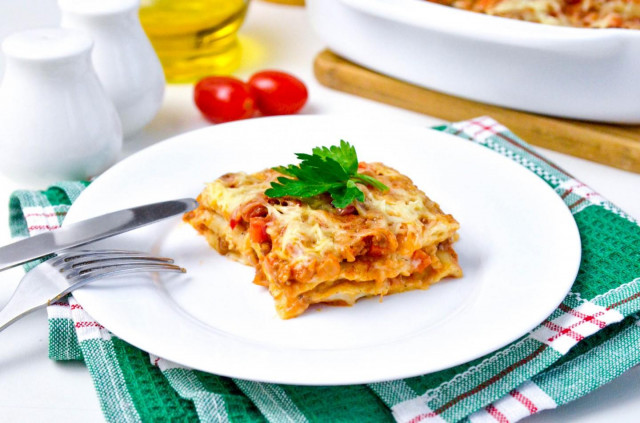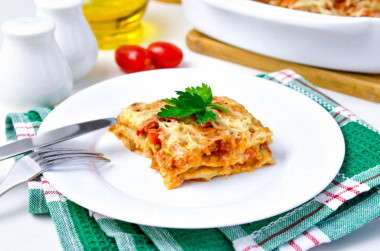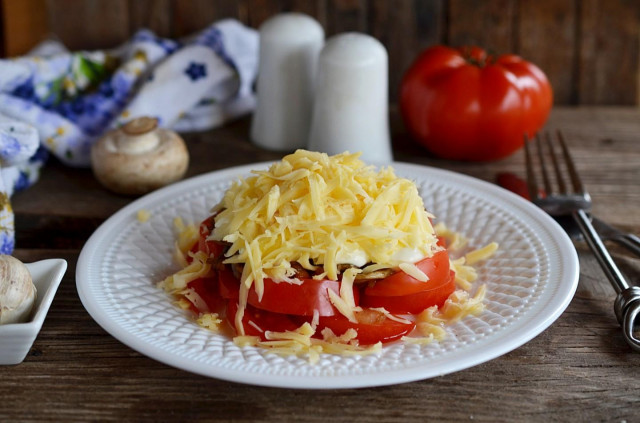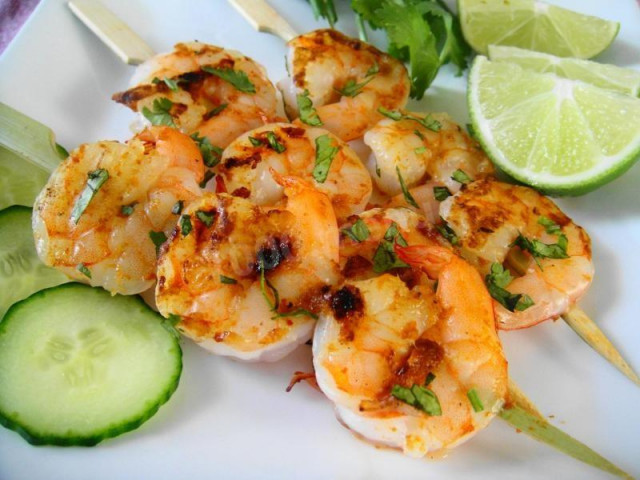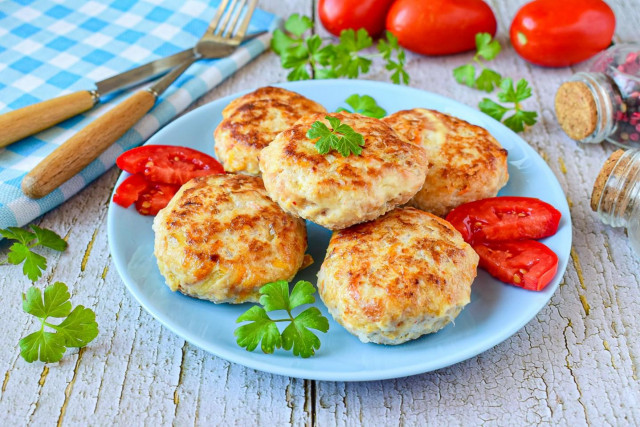Composition / ingredients
Step-by-step cooking
Step 1:

How to make Italian classic lasagna? First of all, prepare the bolognese sauce. Prepare the products for him. Minced meat is better to take mixed — beef-pork, celery stalks are also put from vegetables. Instead of tomatoes, I took the finished mashed pulp. As a seasoning, I have herbs of Italian cuisine. If taken separately, then take oregano, basil, thyme, rosemary.
Step 2:
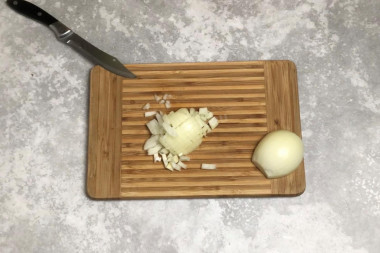
How to make bolognese sauce? Peel the onion and cut into small cubes.
Step 3:

Also cut the peeled carrots into cubes.
Step 4:
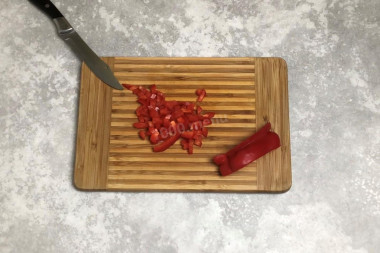
And bell pepper.
Step 5:
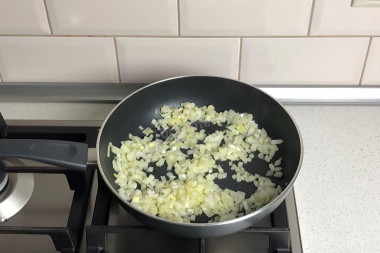
Heat the frying pan, pour olive oil into it. Put the onion. Fry it until transparent over medium heat.
Step 6:

Add carrots and pepper to the onion. Stir-fry for a few more minutes.
Step 7:

Put the minced meat to the vegetables, break it well with a spatula. Fry everything together for about 5 minutes.
Step 8:

Add salt, pepper and seasonings. Pour in the tomato pulp. If you have fresh tomatoes, then remove the skin from them, chop them finely and put them in minced meat, pouring a little more water. Mix it up. Simmer the sauce for 10 minutes over low heat.
Step 9:

Next, prepare the bechamel sauce. Prepare the products for him. Milk is suitable for any fat content. The oil is natural, high—quality, without milk fat substitutes.
Step 10:
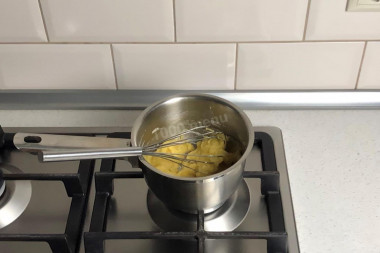
How to make bechamel sauce? In a bowl with a thick bottom, melt the butter without bringing it to a boil. Pour flour into the butter. Mix well with a whisk. Fry the flour for a few minutes on low heat until light nutty flavor. It is necessary to mix the flour all the time so that it does not burn.
Step 11:
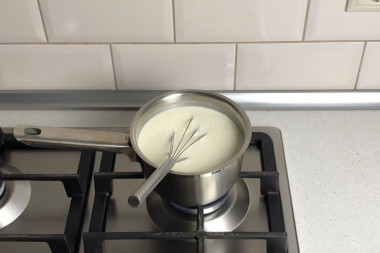
With constant stirring, pour in a thin stream of milk. Cook the sauce until thickened, about 5 minutes. During cooking, stir the sauce intensively. Then add salt, pepper and nutmeg. Mix it up.
Step 12:
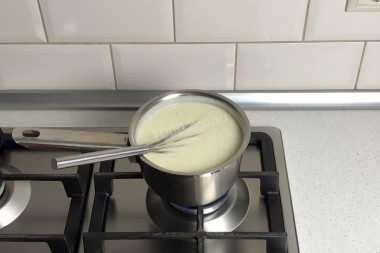
Continue to cook the sauce to the desired consistency — it should become like thick sour cream. Bechamel sauce is best used immediately after cooking, since when it cools down, a milk foam forms on top of it. If you cook it in advance, then cover the sauce with cling film on top so that it lies on the surface of the mass.
Step 13:
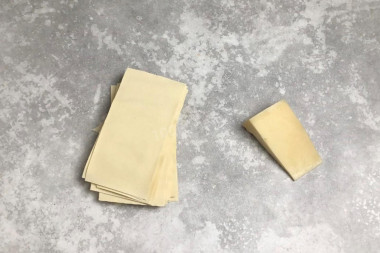
It remains to collect lasagna. You will need dry sheets for lasagna and hard cheese. I have pasta for lasagna, which does not need to be pre-cooked. If your pasta requires cooking, then boil it according to the instructions on the package.
Step 14:

Grate the cheese on a fine grater.
Step 15:

Pour the bechamel sauce on the bottom of the mold, smear it.
Step 16:
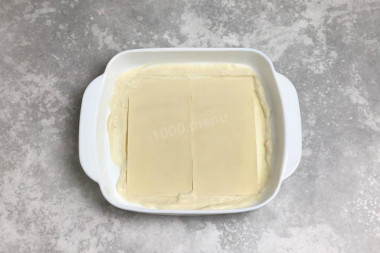
Put the lasagna sheets.
Step 17:
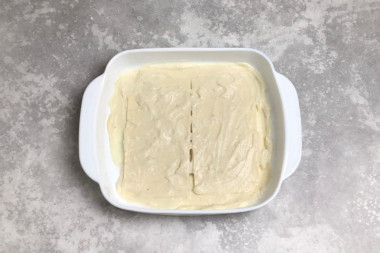
The bechamel sauce is on top of the sheets again.
Step 18:
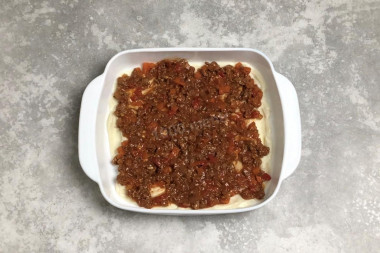
The next layer is bolognese.
Step 19:
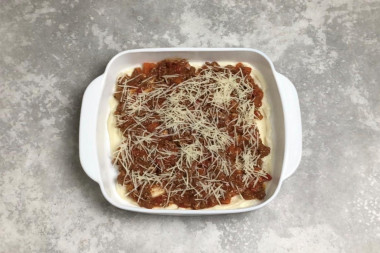
Sprinkle cheese on top of it.
Step 20:
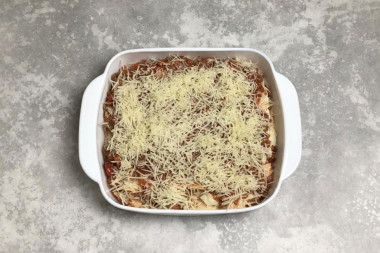
Then repeat the sequence of layers. Bechamel-sheets-bechamel-bolognese-cheese. The number of layers depends on the height of the shape. I repeated it three times. In order for the sheets to occupy the entire surface of the mold, they can be broken and filled with voids. The top layer is always bolognese plus cheese on top.
Step 21:
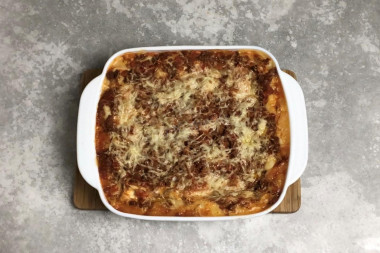
Bake the lasagna in the oven at 190 °C for 30-40 minutes. The top will turn brown, and the cheese will melt. Remove the finished dish from the oven and serve immediately. Enjoy your meal!
Any cheese is suitable for this dish — hard, semi-hard, soft, like mozzarella. The main thing is that it is delicious, high-quality, without milk fat substitutes and melts well.
Keep in mind that everyone's ovens are different. The temperature and cooking time may differ from those specified in the recipe. To make any baked dish successful, use the useful information about the features of ovens !
Any oils are useful only until a certain temperature is reached - the point of smoking, at which the oil begins to burn and toxic substances, including carcinogens, are formed in it. How to determine the roasting temperature and choose the best oil for frying, and which is better not to use at all, read here .
Caloric content of the products possible in the composition of the dish
- Onion - 41 kcal/100g
- Tomatoes - 23 kcal/100g
- Whole cow's milk - 68 kcal/100g
- Milk 3.5% fat content - 64 kcal/100g
- Milk 3.2% fat content - 60 kcal/100g
- Milk 1.5% fat content - 47 kcal/100g
- Concentrated milk 7.5% fat content - 140 kcal/100g
- Milk 2.5% fat content - 54 kcal/100g
- Sweet pepper - 27 kcal/100g
- Carrots - 33 kcal/100g
- Dried carrots - 275 kcal/100g
- Boiled carrots - 25 kcal/100g
- Dutch cheese - 352 kcal/100g
- Swiss cheese - 335 kcal/100g
- Russian cheese - 366 kcal/100g
- Kostroma cheese - 345 kcal/100g
- Yaroslavsky cheese - 361 kcal/100g
- Altai cheese 50% fat content - 356 kcal/100g
- Soviet cheese - 400 kcal/100g
- Cheese "steppe" - 362 kcal/100g
- Uglich cheese - 347 kcal/100g
- Poshekhonsky cheese - 350 kcal/100g
- Lambert cheese - 377 kcal/100g
- Appnzeller cheese with 50% fat content - 400 kcal/100g
- Chester cheese with 50% fat content - 363 kcal/100g
- Edamer cheese with 40% fat content - 340 kcal/100g
- Cheese with mushrooms of 50% fat content - 395 kcal/100g
- Emmental cheese with 45% fat content - 420 kcal/100g
- Gouda cheese with 45% fat content - 356 kcal/100g
- Aiadeus cheese - 364 kcal/100g
- Dom blanc cheese (semi-hard) - 360 kcal/100g
- Lo spalmino cheese - 61 kcal/100g
- Cheese "etorki" (sheep, hard) - 401 kcal/100g
- White cheese - 100 kcal/100g
- Fat yellow cheese - 260 kcal/100g
- Altai cheese - 355 kcal/100g
- Kaunas cheese - 355 kcal/100g
- Latvian cheese - 316 kcal/100g
- Limburger cheese - 327 kcal/100g
- Lithuanian cheese - 250 kcal/100g
- Lake cheese - 350 kcal/100g
- Gruyere cheese - 396 kcal/100g
- Ground black pepper - 255 kcal/100g
- Whole durum wheat flour fortified - 333 kcal/100g
- Whole durum wheat flour, universal - 364 kcal/100g
- Flour krupchatka - 348 kcal/100g
- Flour - 325 kcal/100g
- Butter 82% - 734 kcal/100g
- Amateur unsalted butter - 709 kcal/100g
- Unsalted peasant butter - 661 kcal/100g
- Peasant salted butter - 652 kcal/100g
- Melted butter - 869 kcal/100g
- Mixed minced meat - 351 kcal/100g
- Salt - 0 kcal/100g
- Spices dry - 240 kcal/100g
- Olive oil - 913 kcal/100g
- Lasagna sheets - 337 kcal/100g
- Nutmeg - 556 kcal/100g

